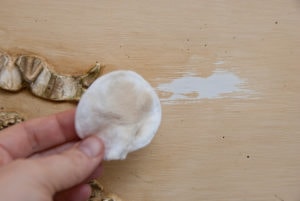How to Tell If I have Oil or Latex Paint on My Walls and/or Trim?
Is Painting Your Ceiling The Same As The Wall Color a Good Idea?
January 30, 2016What are the Best Deck Finishes?
February 11, 2016It is really important to know what type of paint you currently have on the walls or trim. Typically, most homes that were built before 1970s had all their trim plus walls and ceilings in kitchen, bath and laundry painted with oil-based paint products. Oil-based paints were most commonly used at that time and by many painters up to the early 2000’s However, if you are  still not sure what type of paint yo have, you can perform a quick test.
still not sure what type of paint yo have, you can perform a quick test.
Rub the Surface With Denatured Alcohol:
- First clean the surfaces well with any household cleaner to remove any dirt
- With a cotton rag or cotton ball, rub denatured alcohol (available at paint store) on the surface. If the paint comes off onto the rag, you have a water based paint with an acrylic latex base. If no paint comes off after a second rubbing then you have oil based paint with an alkyd oil base.
Regardless of the type of paint, clean all surfaces very well before painting
- If trim surface is presently oil based; sand it well so that there will be a microscopically rough surface for new coating to adhere to. Once sanded, you can go over with your topcoat of either hybrid oil or acrylic (but only if sanded well!) If in doubt, use an intermediate coat of acrylic bonding primer before your finish coat of oil or water based paint.
- If trim surface is presently water based enamel, I still encourage sanding….but because some water based enamels do not dry sand well, I recommend wet sanding to achieve a paintable surface. A sanding sponge and a squirt bottle of water with a little dishwashing liquid will allow you to get a very nice surface with no dust. Be sure to wipe down the surface with clear water and a clean rag to remove any soap/dust residue.
- If you are painting walls and ceilings that are presently oil enamel, you must de-gloss the surfaces with TSP or sanding as even new oil enamel will not stick well to old oil enamel…when in doubt, use a bonding primer before your finish coat.
- Yes you can paint water based over oil enamel and get good results BUT, you must use a first coat of bonding primer to assure proper adhesion.
There are some significant differences between oil and latex based paints. Top quality oil based paints tend to be very smooth when touched. At the same time, cheap acrylic latex paints can have a more rubbery feel. A cheap oil can take forever to dry and yellow in time while a premium grade acrylic will keep its color and be as hard and smooth as an automobile finish (as a matter of fact, many auto finishes are water thinned now!)
They key is to buy the proper paint for the intended surface….exterior trim is often best painted with a softer, more flexible water base acrylic so that the paint flexes and moves with the extreme temperature changes (something oil enamels do not do well) Oil enamel can be the preferred choice for s deep glossy look on a protected front door. There is no one paint type that fits all the needs on all the interior and exterior surfaces of a home.

